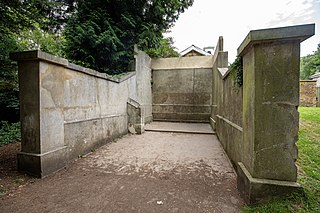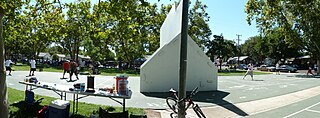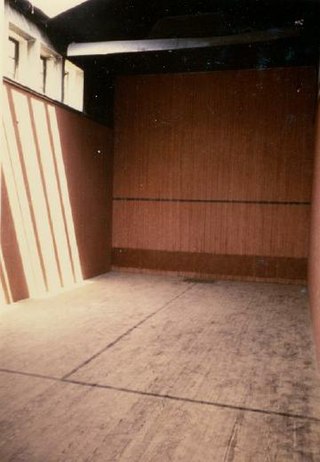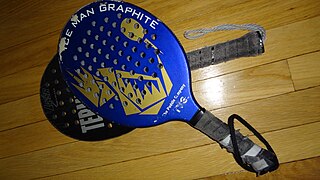
Badminton is a racquet sport played using racquets to hit a shuttlecock across a net. Although it may be played with larger teams, the most common forms of the game are "singles" and "doubles". Badminton is often played as a casual outdoor activity in a yard or on a beach; formal games are played on a rectangular indoor court. Points are scored by striking the shuttlecock with the racquet and landing it within the other team's half of the court.

Tennis is a racket sport that is played either individually against a single opponent (singles) or between two teams of two players each (doubles). Each player uses a tennis racket that is strung with cord to strike a hollow rubber ball covered with felt over or around a net and into the opponent's court. The object of the game is to manoeuvre the ball in such a way that the opponent is not able to play a valid return. The player who is unable to return the ball validly will not gain a point, while the opposite player will.

Table tennis is a racket sport derived from tennis but distinguished by its playing surface being atop a stationary table, rather than the court on which players stand. Either individually or in teams of two, players take alternating turns returning a light, hollow ball over the table's net onto the opposing half of the court using small rackets until they fail to do so, which results in a point for the opponent. Play is fast, requiring quick reaction and constant attention, and is characterized by an emphasis on spin relative to other ball sports, which can heavily affect the ball's trajectory.

Racquetball is a racquet sport and a team sport played with a hollow rubber ball on an indoor or outdoor court. Joseph Sobek invented the modern sport of racquetball in 1950, adding a stringed racquet to paddleball in order to increase velocity and control. Unlike most racquet sports, such as tennis and badminton, there is no net to hit the ball over, and, unlike squash, no tin to hit the ball above. Also, the court's walls, floor, and ceiling are legal playing surfaces, with the exception of court-specific designated hinders being out-of-bounds. Racquetball is played between various players on a team who try to bounce the ball with the racquet onto the ground so it hits the wall, so that an opposing team’s player cannot bounce it back to the wall.

Squash, sometimes called squash rackets, is a racket-and-ball sport played by two or four players in a four-walled court with a small, hollow, rubber ball. The players alternate in striking the ball with their rackets onto the playable surfaces of the four walls of the court. The objective of the game is to hit the ball in such a way that the opponent is not able to play a valid return. There are about 20 million people who play squash regularly world-wide in over 185 countries. The governing body of squash, the World Squash Federation (WSF), is recognized by the International Olympic Committee (IOC), and the sport is included in the Olympic Games, after a number of applications. Squash has been added for the 2028 Summer Olympics in Los Angeles. The Professional Squash Association (PSA) organizes the pro tour.

Eton fives, a derivative of the British game of fives, is a handball game, similar to Rugby fives, played as doubles in a three-sided court. The object is to force the other team to fail to hit the ball 'up' off the front wall, using any variety of wall or ledge combinations as long as the ball is played 'up' before it bounces twice. Eton fives is an uncommon sport, with only a few courts, most of them as part of the facilities of the independent schools in the United Kingdom.

Real tennis – one of several games sometimes called "the sport of kings" – is the original racquet sport from which the modern game of tennis is derived. It is also known as court tennis in the United States, royal tennis in England and Australia, and courte-paume in France. Many French real tennis courts are at jeu de paume clubs.

Fives is an English handball sport derived from jeu de paume, similar to the games of handball, Basque pelota, and squash. The game is played in both singles and doubles teams, in an either three- or four-sided court.

American handball, known as handball in the United States and sometimes referred to as wallball, is a sport in which players use their hands to hit a small, rubber ball against a wall such that their opponent(s) cannot do the same without the ball touching the ground twice or hitting out-of-bounds. The three versions are four-wall, three-wall and one-wall. Each version can be played either by two players (singles), three players (cutthroat) or four players (doubles), but in official tournaments, singles and doubles are the only versions played.

Squash tennis is an American variant of squash, one played with a ball and racquets that are more similar to the equipment used for lawn tennis, and with somewhat different rules. The game offers the complexity of squash and the speed of racquetball.

Gaelic handball is a sport where players hit a ball with a hand or fist against a wall in such a way as to make a shot the opposition cannot return, and that may be played with two (singles) or four players (doubles). The sport, popular in Ireland, is similar to American handball, Welsh handball, fives, Basque pelota, Valencian frontó, and more remotely to racquetball or squash. It is one of the four Gaelic games organised by the Gaelic Athletic Association (GAA). GAA Handball, a subsidiary organisation of the GAA, governs and promotes the sport.

Rackets or racquets is an indoor racket sport played in the United Kingdom, United States, and Canada. It is infrequently called "hard rackets" to distinguish it from the related sport of squash.

Pickleball is a racket or paddle sport in which two players (singles) or four players (doubles) hit a perforated, hollow plastic ball with paddles over a 34-inch-high (0.86 m) net until one side is unable to return the ball or commits a rule infraction. Pickleball is played indoors and outdoors. It was invented in 1965 as a children's backyard game in the United States, on Bainbridge Island in Washington state. In 2022, pickleball was named the official state sport of Washington.
This page is a glossary of tennis terminology.
Players use different strategies while playing tennis to enhance their own strengths and exploit their opponent's weaknesses in order to gain the advantage and win more points.

Ball badminton is a sport native to India. It is a racket sport game, played with a yellow ball made of wool, on a court of fixed dimensions divided by a net. The game was played as early as 1856 by the royal family in Tanjore, the capital of Thanjavur district in Tamil Nadu, India. It enjoys the greatest popularity in India. Ball badminton is a fast-paced game; it demands skill, quick reflexes, good judgment, agility, and the ability to control the ball with one's wrist.
Traditionally, tennis is played between two people in a singles match, or two pairs in a doubles match. Tennis can also be played on different courts, including grass courts, clay courts, hard courts, and artificial grass courts.

Paddle-ball is a sport that is played on a court half the size of a tennis court, using paddle racquets. The paddle is made of wood or graphite, and has holes to reduce air friction. The game is played with two players or in doubles.

The Downside ball game is an outdoor racquet sport played by Gregorians at Downside School, Stratton-On-The-Fosse, Somerset since 1820. It bears some similarities to Rugby fives; however, it is played with a solid wooden bat rather than one's hand.
This glossary provides definitions and context for terminology related to, and jargon specific to, the sport of pickleball. Words or phrases in italics can be found on the list in their respective alphabetic sections.


















